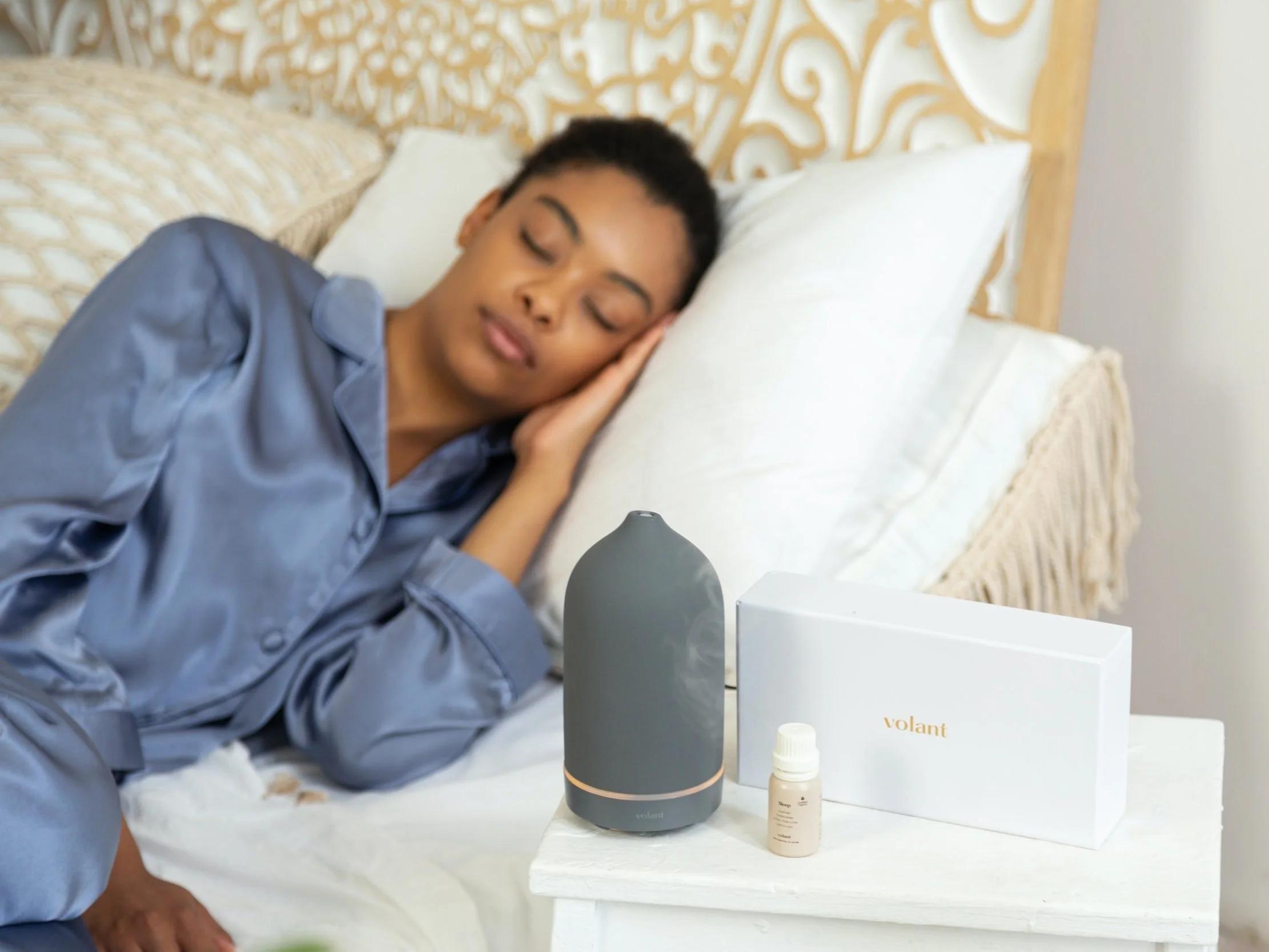SWEET DREAMS: Five Things That Might Just Transform Your Sleep Game
If you follow me on Instagram you might have noticed that this month I am talking about sleep - that rare and precious commodity that often eludes those who live with a chronic pain condition.
Pain, and the anxiety and stress that often accompanies it, is a killer when it comes to getting enough sleep, and not getting our full quota of restorative rest affects our mind and body in ways that carry over into our daily life. Not only does it make it more difficult to manage our pain, lack of sleep can actually increase our pain. It impacts every aspect of our life: our physical and mental health, our work, our confidence, and our relationships. The opposite is also true - when we get our sleep back, we often get our life back too. Sleep can transform our wellbeing.
I have been obsessed with getting a good night’s sleep for over twenty years now, and I have ‘perfected’ my sleep hygiene routine several times over the years. But the ability to sleep, like pain, and many other aspects of feminine life, moves in cycles, and ebbs and flows. What may work one night, week, or month, may not work the next, and just when you think you have your sleep game nailed, you’re back to square one. It’s a constant struggle.
During Covid lockdown #one I started taking my sleep routine really, really seriously and I made five purchases that have transformed my sleep game. I’m sharing them here because they might just transform yours too.
(Please note: I am not being paid to promote these products).
Weighted blankets - what are they?
A weighted blanket is a heavy blanket, or duvet, used for therapeutic purposes, and the weight comes from either glass, metal, or plastic beads that are sewn into pockets to distribute the weight across the blanket. This added weight is designed to produce a calming effect when placed over the body. Initially they were most commonly used as therapeutic tools to assist individuals with autism, dementia, and mental health conditions, to aid sleep and reduce anxiety, but recently they have become popular with the mass market since studies have shown that they help a much wider range of health problems.
How do they work?
Weighted blankets use a technique called deep pressure stimulation (DPS) to relax the nervous system by making the user feel more secure, and by lightly pressing on the body (like a hug) they release oxytocin, increasing the amount of dopamine and serotonin in the brain. These feel-good chemicals create a sense of calm, happiness, and well-being. Serotonin aids the sleep-wake cycle by regulating the sleep stages, and also impacts the depth of sleep, helping us to sleep more peacefully and soundly. People who use a weighted blanket often notice that they fall asleep faster, stay asleep longer, have fewer disruptions during their sleep, and experience overall improved quality of sleep.
Do they help people who live with chronic pain?
Studies have shown that people who live with chronic pain have found comfort from the use of a weighted blanket. As well as easing symptoms by reducing the perception of pain, and therefore aiding sleep, it can also help to break the cycle of anxiety and depression that can often accompany the condition.
The cocooning effect provided by a weighted blanket can also reduce movements during the night, so if your pain has you tossing and turning, having the blanket on top of your body while sleeping can lead to a more restful sleep which should make your pain more manageable the next day.
Using a weighted blanket can also lead to overall improvements in mood. The oxytocin produced by the hug-like pressure of the blanket, combined with the decrease in the stress hormone cortisol, can have a significant impact on the user’s state of mind - and waking in a good mood can have a significant impact on how well we manage our pain the next day.
Choosing a weighted blanket
There are dozens of weighted blankets on the market today and I would recommend doing research before you decide on one to buy as there are many things to consider, including the weight and size of the blanket as well as your own weight and age. Also there are certain categories of health conditions for which weighted blankets are not suitable, so do check out all the options and research the advantages and disadvantages. If you google 'weighted blanket’, several websites will pop up in the results that have tried and tested various brands of blanket and ranked their pros and cons which can be a good place to start to prevent overwhelm!
My experience of using a weighted blanket
Initially I was a bit sceptical before buying because weighted blankets can be pricey, but I can honestly say that it was worth every single penny I spent. I went for the Koala Therapeutic Weighted Blanket set by Kuddly because it was ranked high in every single comparison review I looked at and I was swayed by the removable and washable all-season cover that comes in soft neutral grey.
The blanket is available in two sizes and three weights, and comes with a two-sided duvet cover that is designed for all year round comfort - a cool side which is temperature regulating 100% eco-friendly bamboo, and a warm side which is 100% polyester that feels like lush velvet.
The first night I used my weighted blanket was the best night’s sleep I had in months and I fell in love with it immediately. I was worried that using the blanket every night might reduce it’s effectiveness over time, a bit like becoming too used to your pain medication, so I save it for the nights when my pain is at such a level that I know I am not going to be able to sleep without it.
My blanket helps me to not only fall asleep faster, but to also sleep longer, and with fewer disruptions during the night - it has been a sleep saviour, better than any sleep-inducing drug because I wake up feeling clear-headed and brighter the next morning.
There are several sunrise/sunset clocks on the market but I’m going to sing the praises of The Lumie Bodyclock, because that is the one I have and it has changed my life by regulating my sleep-wake cycle with it’s realistic sunrise and sunset!
Sunrise / sunset clocks - what are they?
Instead of being rudely jolted from sleep by an alarm, a sunrise / sunset (or sleeping / waking) clock will wake you gradually and more effectively with steadily brightening light that gently rouses you from sleep. By the time you open your eyes, you're properly awake, alert, more energised and feeling ready for the day ahead.
At bedtime, a fading sunset creates an environment where sleep comes easily. By promoting your body’s natural sleep response it helps you drift off naturally, leaving you rested and refreshed when you wake next morning.
Clinical trials have shown that these clocks not only regulate your sleep-wake cycle, but also improve the quality of sleep and awakening, as well as boosting mood, energy and productivity
There are a range of clocks at different price points to choose from, with some models having extra customisation options which allow you to choose the duration of the sunset and sunrise, tailor the light intensity of the sunrise alarm and add complementary sleep/wake sounds. For example, you can fall asleep to the gentle rhythm of rolling thunder... then wake to a bright sunrise filled with tropical birds or bleating goats. As close to a truly natural start and end to the day as you can get.
My experience of using a sunrise / sunset clock
I purchased the Lumie Bodyclock Spark 100 which doesn’t have added sounds because I naturally wake earlier than my husband and I didn’t want him to complain about being rudely awoken by bleating goats and tropical birds!
I can honestly say, for me, it has been a game-changer in the battle to reset my circadian rhythm. I no longer have to set an alarm bell - the gently brightening sunrise light is enough to wake me gradually so I am wide-awake and alert when the alarm time is reached. Then, when I climb under the covers at the end of the day, the gently fading sunset light (sometimes used in conjunction with the other products below) helps me to achieve a state of relaxation that enables me to easily drift off to sleep.
SWEET DREAM PURCHASE #3
The Oil Diffuser
How do oil diffusers work?
Put simply, essential oil diffusers work by emitting essential oils into the air, which means you can inhale and absorb the benefits of the oils into your body, aiding relaxation.
Essential oils are concentrated compounds extracted from roots, seeds, flowers, bark and other natural plant products, which have been used for centuries for their benefits in healthcare, skincare, oral hygiene and food preparation. Drawing on the principles of aromatherapy, they stimulate the body's reaction to scent, triggering different emotional and physical responses, and can help create a calming and sleep-inducing environment.
Different oils spark various responses in our hypothalamus gland, triggering the production of hormones which then activate different responses in the body as chemical messages are sent to specific cells to stimulate particular health benefits.
Diffusing essential oils, or releasing them into the air, with an electrical diffuser is one of the most popular ways to use oils today, as it spreads the essential oil throughout your room for the length of time you choose. When certain essential oil blends are used in conjunction with an essential oil diffuser they can help with both sleep and anxiety, which is great news for those who live with a chronic pain condition.
What are the benefits?
Different oils have different benefits but they can include relaxation and reduction in stress and anxiety, which in turn can lead to better sleep, more energy, change in perception of pain, or improved mood.
What are the best essential oils to aid sleep?
Lavender is by far one of the most popular essential oils when it comes to aiding sleep as it is well known for for its relaxation properties. Some studies have shown it to be an excellent natural remedy for helping to treat insomnia and boosting sleep quality, and it is often used as an ingredient in pillow spritzers to help you drift off to sleep.
Others include:
Chamomile - good for sleep, anxiety, and pain relief
Bergamot - good for improved mood, anxiety, and stress relief
Cedarwood - good for sleep, anxiety, and stress relief
Ylang Ylang - good for pain relief, relaxation, improved mood, anxiety, and stress relief
Frankincense - relaxation, encouraging slower and deeper breathing
Clary Sage - good for anxiety and stress reduction
Choosing an oil diffuser
The challenge with essential oils is making sure that enough of the oils are diffused to allow you to feel the benefits of aromatherapy, but not so much that the effect is overpowering. And, like many things, essential oils when used in a diffuser are safe as long as it is being used properly.
There are hundreds of different oil diffusers on the market and it is easy to get lost when choosing which to buy so take time to do your research, read reviews and consider all the pros and cons. Here are a few things to keep in mind:
Don’t just go for the cheapest as low-cost might mean low-quality
Avoid diffusers which heat the oils as this disturbs their delicate chemistry and makes them less effective.
Is the diffuser easy to clean?
Does it have a timer / allow you to set the desired time of release? (Over exposure can irritate breathing passages).
Precautions
Always use caution with essential oils, especially when you first start trying them. Keep your eye out for any adverse reactions and keep away from pets.
Use only quality oils.
Do your research before use as some oils shouldn’t be blended together, and some oils shouldn’t be used when you have certain health conditions.
My experience of using an oil diffuser
I have found that using an oil diffuser in the bedroom has been really beneficial when it comes to aiding sleep, particularly on the nights when my pain levels are highest. I mainly use lavender oil but also find chamomile and ylang ylang conducive to gently drifting off to sleep and helpful for their relaxation and stress-relief properties.
I like to switch the oil diffuser on thirty minutes before bedtime, so that the bedroom is already a relaxing environment when I am ready to climb beneath the covers, and I set the timer so that it runs for another thirty minutes after I get into bed by which time I hope to be fast asleep.
SWEET DREAM PURCHASE #4
Bluetooth Sleep Mask
What is it?
A bluetooth sleep mask is a black-out eye mask with inbuilt headphones. Usually made from soft and comfortable fabric with padded built-in speakers, they block out light, suit any sleeping position, and are compatible with any bluetooth device, so you can enjoy an immersive audio experience to help you relax and drift off to sleep.
How do they help?
It is no secret that noise and light can disturb your sleep pattern or prevent you falling asleep in the first place. When you live with a chronic pain condition you already have pain, stress and anxiety keeping you awake, so when you throw in the usual waking culprits of noise and light, it just adds up to a fairly toxic anti-sleep cocktail. A bluetooth sleep mask tackles both problems at once - cutting out light completely, and allowing you to play relaxing sounds to cover up any annoying outside noise.
Choosing a bluetooth sleep mask
There are hundreds of bluetooth sleep masks on the market, but here are some things to consider to help you make a choice:
What is the fabric - is it breathable?
Are the speakers thin and padded for comfort?
Are the speakers removable so the mask can be washed when necessary?
How long does the mask take to charge? How much playing time do you get from one charge?
Can the mask be used in your normal sleeping position?
How well does it block light?
My experience of using a bluetooth sleep mask
I purchased a headband style bluetooth mask because I just wanted it for the immersive audio experience and not to block out light. I have black-out blinds on my bedroom window to shut out unwanted light so I wear the headband mask so that the in-built speakers are positioned over my ears but the mask isn’t covering my eyes because I don’t want it to interfere with the beneficial light from my sunrise / sunset clock.
I find that when I am playing music or soundscapes through the speakers in the mask, not only does it shut out unwanted noise (like my husband’s snoring) but it is an extremely relaxing experience which very rarely fails to help me drift off to sleep.
SWEET DREAM PURCHASE #5
The Sleep Sound App
Sleep sound apps, what are they?
Sleep audio apps are a fairly recent addition to the better sleep toolkit and are nothing short of amazing when it comes to promoting regular sleep patterns. They are designed to help you relax at bedtime and say goodbye to insomnia by playing sounds and music on your phone, or through bluetooth headphones.
There are quite a few sleep apps on the market and usually they will include a choice of audio experiences to help you drift off to sleep, including relaxing sounds from nature, sleep-inducing music, bedtime story recordings, and mindfulness meditations.
A few to check out include Calm, Slumber, Bettersleep, and Aura.
My experience of using sleep sound apps
I use the Calm app, which I find has a great library of audio resources that help my personal needs when it comes to blocking out unwanted noise, calming my mind, and relaxing my body to achieve a state of deep relaxation conducive to sleep.
I use the app in conjunction with my bluetooth sleep mask / headband which means that I can listen to whatever I want without disturbing my husband, at the same time blocking out his snoring. No matter how I am feeling, whatever mood I am in, there is something in the library to help every scenario of sleep-struggle. Some nights I choose a sleep soundscape (‘Sea of Diamonds’ and ‘Ocean Waves’ are my favourites), others a sleep story by Jerome Flynn or Cillian Murphy (I have yet to stay awake to hear a full story), or some ambient music - remixes of Katy Perry’s ‘Double Rainbow’ , Jhené Aiko’s ‘While We’re Young’, and Joy Oladokun’s ‘Breathe Again’ work really well for me.
I use the timer function to set my chosen audio experience to run for thirty minutes, by which time I am usually in a deep sleep. If I waken during the night (a common occurrence with a chronic pain condition) I go to the toilet to empty my bladder, take a few sips of water, and reset the timer and usually I am back to sleep in a matter of minutes. No matter what sounds I am in the mood for, I get to fall asleep peacefully, and awake rested and refreshed.







